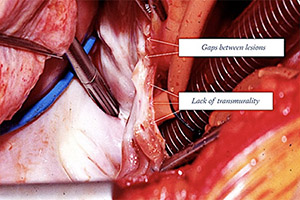Fabrizio Rosati, Massimo Baudo, Michele D’Alonzo, Lorenzo Di Bacco, Gianmarco Arabia, Claudio Muneretto
AbstractAtrial fibrillation (AF) has been reported as a major cause of cardiac morbidity and mortality, and significantly reduces the quality of life in symptomatic patients. Current guidelines recommend antiarrhythmic drugs and catheter ablation (CA) as first-line therapy. Despite CA showed to be associated with lower incidence of peri-procedural complications, rhythm outcomes are far from optimal. Indeed, patients undergoing CA frequently require multiple AF ablation procedures, especially in those with persistent and long-standing persistent AF. While surgical ablation can provide transmural lesions, surgical invasiveness has limited the widespread use of this approach due to the increased perioperative complications. The development of minimally invasive thoracoscopic approaches has renewed the interest towards surgical ablation, thus favoring more simplified ablation sets. Therefore, the concept of “hybrid” ablation has emerged in order to theoretically enhance advantages of both minimally invasive and CA procedures while seeking to improve rhythm outcomes and reduce invasiveness and incidence of perioperative complications. On one hand, it provides the effectiveness of a surgical ablation, on the other, electrical mapping during CA can identify and treat any ablation gap or provide additional ablation lines, thus improving the chance of a stable sinus rhythm restoration at long-term follow-up. Three main thoracoscopic strategies are currently available. All of them can be performed in conjunction with the “catheter ablation procedure”: the “Fusion” technique, the bipolar clamp technique, and the most recent “convergent” technique. CA can be performed either simultaneously or with a staged approach after a blanking period in order to allow the ablation lesion to stabilize. Excellent results of the hybrid procedures have been reported in terms of rhythm outcomes and incidence of perioperative complications. This narrative review aims to discuss the rationale behind the concept of hybrid ablation for the treatment of AF regarding different available strategies, results and expert opinions.
Cover
留言 (0)